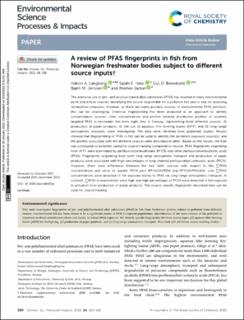A review of PFAS fingerprints in fish from Norwegian freshwater bodies subject to different source inputs
Peer reviewed, Journal article
Published version
Permanent lenke
https://hdl.handle.net/11250/2987386Utgivelsesdato
2022Metadata
Vis full innførselSamlinger
- Publikasjoner fra Cristin - NIVA [2149]
- Scientific publications [1172]
Sammendrag
The extensive use of per- and polyfluorinated alkyl substances (PFAS) has resulted in many environmental point and diffuse sources. Identifying the source responsible for a pollution hot spot is vital for assessing remediation measures, however, as there are many possible sources of environmental PFAS pollution, this can be challenging. Chemical fingerprinting has been proposed as an approach to identify contamination sources. Here, concentrations and profiles (relative distribution profiles) of routinely targeted PFAS in freshwater fish from eight sites in Norway, representing three different sources: (1) production of paper products, (2) the use of aqueous film forming foams (AFFF), and (3) long-range atmospheric transport, were investigated. The data were retrieved from published studies. Results showed that fingerprinting of PFAS in fish can be used to identify the dominant exposure source(s), and the profiles associated with the different sources were described in detail. Based on the results, the liver was concluded to be better suited for source tracking compared to muscle. PFAS fingerprints originating from AFFF were dominated by perfluorooctanesulfonate (PFOS) and other perfluoroalkanesulfonic acids (PFSA). Fingerprints originating from both long-range atmospheric transport and production of paper products were associated with high percentages of long chained perfluoroalkyl carboxylic acids (PFCA). However, there were differences between the two latter sources with respect to the ∑PFAS concentrations and ratios of specific PFCA pairs (PFUnDA/PFDA and PFTrDA/PFDoDA). Low ∑PFAS concentrations were detected in fish exposed mainly to PFAS via long-range atmospheric transport. In contrast, ∑PFAS concentrations were high and high percentages of PFOS were detected in fish exposed to pollution from production of paper products. The source-specific fingerprints described here can be used for source tracking.

